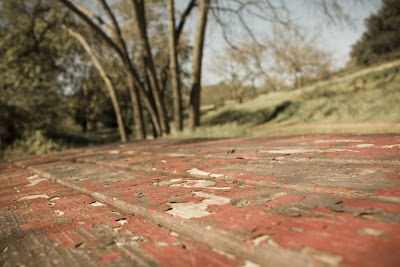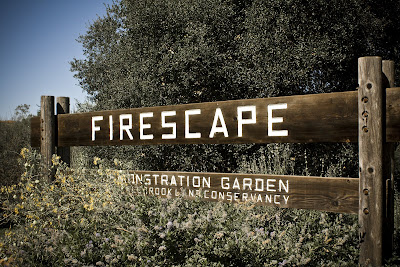
On Monday, March 23, 2009, our class had the opportunity to visit the Indian Rock Native Garden in Vista, California. Driving the the garden was a bit unusual though. Our professor had mentioned that it is in the middle of a residential area, but until you are there, you do not fully comprehend how residential it is. Pulling up to the garden, which is surrounded by a simple, chain link fence, I saw that opposite the garden, the street was lined with homes. I was a bit worried about parking in front of a stranger's house, but I did my best to park out of the way.
After parking, I met up with a few of my classmates and walked through the open gate and up a dirt path. Immediately, I noticed the large, tagged rock on top of the hill. Being the only large rock in the area, I knew that was the Indian Rock the garden's title promised. The dirt trail wound around the hill, curving to the left. As I followed it, I found more of my classmates, and our professor. At the moment, not all of our classmates had arrived for our prearranged tour with Alan, a native Luiseno of Vista, and Greg, our native plant guide. Alan indicated that we could go ahead and walk up the small trail to take a look at the rock while we waited for everyone to arrive. Walking up the hill, it was hard not to notice all the beautiful yellow flowers that were starting to bloom (which I learned were Yellow Mallows from our tour with Greg).
Arriving at the top of the hill, there was a large open area, leveled and paved with stones and concrete. To my right I noticed the leftover foundation of a previous structure, and straight ahead of me was the Indian Rock. From this angle, the rock was clean, and untagged by local gangs. To my left, trees and vegetation grew. Some laurel sumac, a non-native citrus tree, and a smaller rock completely covered by wild cucumber.

Personally, I found the rock covered by wild cucumber to be extremely beautiful. The little white blooms and green, prickly fruit covered the rock, giving it an ancient look. I wandered closer to the larger rock in front of me, and made my way around to get a closer look at the front side I had seen first walking into the garden area. It's face seemed almost scarred by the blue and white paint left by a local Vista gang, better known as the Vista Home Boys. Looking at the graffiti, I felt sorry for the rock, alone on a hill, unable to protect itself in the middle of suburbia.


After exploring the landscape around the rock for about 15 minutes, the rest of our group had arrived, along with other local natives, as well as some Vista city council members. Alan introduced himself to us and his involvement with the Indian Rock Native Garden, as well as gave us the background on the garden. He told us about how the rock was important in coming-of-age ceremonies for young women of the Luiseno people. He further told us about their efforts in restoring the native plants of the garden. At this point, Alan let Greg take over the tour. I was extremely impressed by the vast knowledge Greg had about native plants!!!

One of the most interesting things he told us was how drought and fire resistant the native plants can be, which really surprised me. After listening to this and seeing how beautiful the native plants are, I am really surprised people in southern California are not more interested in using native plants for landscaping. Greg took us from the bottom of the hill, all the way back up to the Indian Rock at the top, stopping along the way to give us information on each plant we saw. At the top, Alan took over again, and got even more in depth in the importance of the rock and native garden in preserving the local history of the area. He even mentioned the pictographs on the front of the rock, which I had not even seen earlier because of all the graffiti. Alan told us that the paint from the pictographs will long out live the everyday spray paint, which helped ease some of my concern. Truthfully, I think it is such a shame that these gang members are so ignorant they do not realize or even care how their territorial tagging is vandalizing an important piece of history.
After our wonderful and insightful tour, Alan and a group from the local Luisenos were kind enough to provide some sandwiches, chips, salads, and drinks for us. I was really moved by how welcoming and generous they were. It is definitely an experience I will not forget any time soon!
Overall, the Indian Rock Native Garden was one of my favorite field trips. After listening to Greg and how passionate he was about all of the native plants, I am definitely considering landscaping my front yard at home with native plants and plenty of mulch!
Here are some more pictures from our trip:
Some coastal oak:

























































